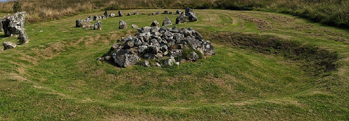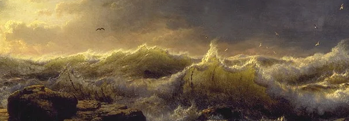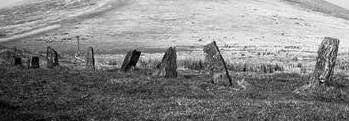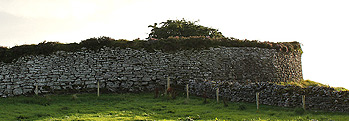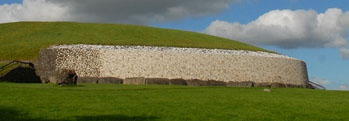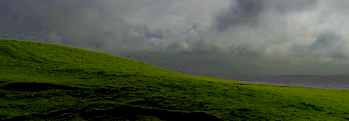Dun Aengus
Irish and Celtic myths and legends, Irish folklore and Irish fairy tales and Legendary Places in Ireland
The breathtaking fortress of Dun Aengus, perched on the edge of a steep cliff
 Dun Aengus means "the Fort of Aenghus", and remains one of the most impressive ancient monuments in Ireland, Europe or the world. Perched on the edge of a high and jagged cliff with the grey-green waters of the Atlantic battering below, it gained its name from its original builders, who were called the Fir Bolg, some of the first to arrive in Ireland and who strove mightily with the Tuatha de Dannan at Moy Tura.
Dun Aengus means "the Fort of Aenghus", and remains one of the most impressive ancient monuments in Ireland, Europe or the world. Perched on the edge of a high and jagged cliff with the grey-green waters of the Atlantic battering below, it gained its name from its original builders, who were called the Fir Bolg, some of the first to arrive in Ireland and who strove mightily with the Tuatha de Dannan at Moy Tura.
"The Fir Bolg gave them battle upon Mag Tuired; they were a long time fighting that battle. At last it broke against the Fir Bolg, and the slaughter pressed northward, and a hundred thousand of them were slain…The Fir Bolg fell in that battle all but a few, and they went out of Ireland in flight from the Tuatha Dé Dannan…
Thereafter they came in flight before Cairbre under the protection of Meldb and Ailill, and these gave them lands. This is the wandering of the sons of Umor. Oengus son of Umor was king over them in the east, and from them are named those territories, Loch CIme from Cime Four-Heads son of Umor, the Point of Taman in Medraige from Taman son of Umor, the Fort of Oengus in Ara from Oengus, the Stone-heap of Conall in Aidne from Conall, Mag Adair from Adar, Mag Asail from Asal in Mumu also. Menn son of Umor was the poet. They were in fortresses and in islands of the sea around Ireland in that wise, till Cu Chulaind overwhelmed them."
After the Fir Bolg it was reputed to have become the last refuge of the feared Fomorian sea demons as well.
It lies within four great stone walls, open on one side to the ocean, and among its most striking features is the circle of jagged stones that surrounds it. These were meant to make approach to the fort difficult, and they'd have done a fine job of it too, for even now the edges of the stones are sharp and you could do yourself a severe injury by falling atop one.
In the heart of the fourteen acre enclosure is a giant stone slab, although to what purpose it was put in the olden days none can say. The fort could see a great distance out to either side as well, and so perhaps acted as a watchtower for invaders, traders or raiders. Its age is unknown but very great, and its history is less known again, but if you're visiting you'd be best to do so during the evenings, when there are fewer visitors.
Dun Aengus still stands where it's marked on the map below.
Legendary Places in Ireland
Ireland is a land of many treasures – some are well known while others are known only to a few, like the mysterious stone circles of Beaghmore! In the north of County Tyrone they can be found, at the edge of the Sperrin mountains looking out over the wide countryside below, dating back to the bronze age and earlier, to the time when the Tuath ... [more]
The royal ringfort of Grianán Ailigh was known as the father of every building in Ireland by the Annals of the Four Masters, who also claimed it was first built in the year 1500 BC, in the time of the Tuatha Dé Danann! A mighty place of strength it is and was and may always be, one of the few locations in Ireland correctly marked on a ... [more]
Knockma of the mists is a place wreathed in secrets and myth where they say sleeps the greatest king of the Sidhe, he whose name was Finnbheara! Should you go for a walk around Knockma Hill, pay close attention to that which you cannot see – a warm breeze meant a good fairy was passing by, and a sudden shiver meant an evil one was close! J ... [more]
Nine is a mystical number in Irish folklore, being thrice three, itself known from ancient times as a mysterious symbol, and so should you happen across nine stones, you would do well to be extra careful! For who knows what might lie sleeping just below the surface. And such a place can be found on the saddle between Sliabh Bán, the White ... [more]
Once upon a time there were many kingdoms in Ireland, and many kings, or perhaps they would have been better known as chieftains, but kings they were for all that. As time went by each of these kingdoms fell and were joined one into the other, but yet a single kingdom still remains in the farthest north and farthest west of the country, and this is ... [more]
Ireland's bones are made of stories, you can hardly step over a rock or walk past an old mound but if it could speak, it would tell you tales you could hardly imagine. But of all the legended glens and fields misty with memory in this ancient nation, there are few with as many secrets hidden in their depths as Lough Gur in county Limerick. S ... [more]
There are tens of thousands of round stone forts in Ireland, some say as many as fifty thousand, if you can believe it, and one of the finest examples we have is at Kilcashel in County Mayo, which comes from the Irish Coill an Chaisil, the woods of the stone fort. Almost perfectly circular in construction, with thick walls two broad men could walk ... [more]
Scattered throughout the Irish countryside are hundreds if not thousands of holy wells, almost all of great antiquity, even predating Christianity. They can take almost any form and show up in any place, shimmering in the shadow of engraved stone monuments, in lapping sea caves where the fresh and salt waters mingle twice a day, as natural springs ... [more]
In county Roscommon there's a place of great antiquity called Oweynagat, which some have mistakenly thought to mean the Cave of Cats, although it has nothing to do with cats - “cath” being the Irish word for “battle” and so it should rightfully be called the battle cave. Indeed it has a long association with the Morrigan ... [more]
The Burren is one of the wonders of Ireland. A rolling rocky landscape of limestone hills and plains, it is marked with history stretching back thousands of years. Nestled in between the limestone slabs are herbs and plants you'd be hard pressed to find elsewhere, hailing from places as far afield as the Arctic and the Mediterranean, kept warm ... [more]
Older than Stonehenge and the great pyramids of Giza stands Newgrange, the heart of legends and mysteries stretching back five thousand years. Situated along the river Boyne near to numerous other such places like Knowth and Dowth, that very same river where Fionn Mac Cumhaill was said to have first found and tasted the salmon of knowledge, and the ... [more]
The seat of the High Kings of Ireland of old, Tara or Temair as it was known then, is said to have been the seat of a hundred and forty two kings, kingships won by battle, contest and merit, not passed down father to son as in more primitive cultures. One of the most important monuments in the sacred Boyne valley, its history stretches back four th ... [more]
Dun Aengus means "the Fort of Aenghus", and remains one of the most impressive ancient monuments in Ireland, Europe or the world. Perched on the edge of a high and jagged cliff with the grey-green waters of the Atlantic battering below, it gained its name from its original builders, who were called the Fir Bolg, some of the first to arriv ... [more]
Crannogs, the name meaning "young trees" for reasons which aren't too clear, were dwelling places for people in Ireland from the time of the Tuatha de Dannan right up to the seventeenth century. They were built on shallow lakes or pools on top of tree trunks stuck into the lake bottom, piles of rocks, mud and other debris or on natura ... [more]
Croagh Patrick or Patrick's Stack is an important place of pilgrimage for Christians throughout Ireland and the world today, some even walking the ascent in their bare feet as penance for their sins. However it was considered a holy place long before St Patrick came to visit, even though it is said he banished the snakes from Ireland while stan ... [more]
Rising from the ocean a short distance off the coast of county Kerry in southern Ireland, Skellig Michael and its smaller brother rear up out of the Atlantic ocean like jagged grey teeth. Famous poet George Bernard Shaw who visited the place in 1910, called it an "incredible, impossible, mad place" and "part of our dream world". ... [more]




